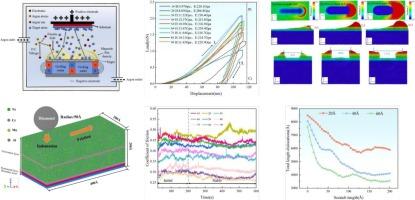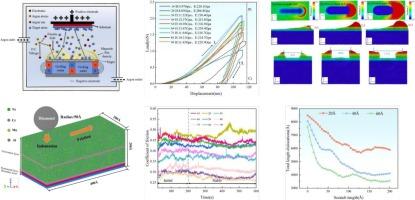调制结构对NiCrMoAl/Al多层复合薄膜微观结构、力学和摩擦学性能的影响
IF 6.9
2区 材料科学
Q2 CHEMISTRY, PHYSICAL
引用次数: 0
摘要
具有多层或梯度结构的刚性薄膜在机械加工中得到了广泛的应用,其中调制结构起着至关重要的作用。本研究利用磁控溅射技术在ZL109铝合金上制备了不同调制结构的薄膜,通过各种表征方法系统分析了薄膜的显微组织、成分状态、力学性能和摩擦学行为,并借助分子动力学模拟从原子尺度上深入了解了其磨损机理。结果表明:薄膜具有均匀的纳米颗粒状、清晰的多层柱状晶体结构,组分分布均匀;调制结构对薄膜性能有显著影响。当调制层数为4层,调制比为8:1时,薄膜硬度和弹性模量分别达到最大值13.67和259.4 GPa。粘结强度在17 N时最佳,平均摩擦系数在0.28时最低,耐磨性最佳。膜的主要磨损机制是磨粒磨损。通过改变摩擦磨损试验载荷,发现随着载荷的增加,膜摩擦系数在高载荷下呈现先增大后趋于稳定的趋势,磨损痕迹的宽度和深度逐渐增大。分子动力学模拟结果表明,压痕深度越大,平均摩擦系数越高,波动越剧烈;同时,压痕深度的增加导致薄膜表面原子聚集增多,形貌变化加剧,高剪切应变区扩大和加深,磨损原子数增加,位错密度逐渐降低。本文章由计算机程序翻译,如有差异,请以英文原文为准。


Effect of modulation structure on microstructure, mechanical and tribological properties of NiCrMoAl/Al multilayer composite films
Rigid films with multilayer or gradient structures have been widely used in machining applications, where their modulation structure plays a crucial role. In this study, magnetron sputtering was used to prepare thin films with different modulation structures on ZL109 aluminium alloy, and their microstructures, compositional states, mechanical properties and tribological behaviors were systematically analyzed by various characterization methods, and the wear mechanism was deeply understood from the atomic scale with the help of molecular dynamics simulation. The results show that the films exhibit uniform nanoparticle-like, clear multilayer columnar crystal structure with uniform compositional distribution. The modulation structure significantly affects the film properties. When the modulation layer count is 4 layers and the modulation ratio is 8:1, the film hardness and elastic modulus reach their maximum values of 13.67 and 259.4 GPa, respectively. The bond strength is optimal at 17 N, the average coefficient of friction is lowest at 0.28, and wear resistance is most favorable. The primary wear mechanism of the film is abrasive wear. By varying the load for friction and wear tests, it was found that as the load increased, the film friction coefficient showed a tendency to increase first and then stabilize at high loads, and the width and depth of the wear marks gradually increased. The molecular dynamics simulation results show that the higher the indentation depth, the higher the average friction coefficient and the more intense the fluctuation; meanwhile, the increase in the indentation depth leads to an increase in the accumulation of atoms on the surface of the thin film, an intensification of the topography change, an expansion and deepening of the high shear strain region, an increase in the number of wear atoms, and A gradual decrease in dislocation density.
求助全文
通过发布文献求助,成功后即可免费获取论文全文。
去求助
来源期刊

Applied Surface Science
工程技术-材料科学:膜
CiteScore
12.50
自引率
7.50%
发文量
3393
审稿时长
67 days
期刊介绍:
Applied Surface Science covers topics contributing to a better understanding of surfaces, interfaces, nanostructures and their applications. The journal is concerned with scientific research on the atomic and molecular level of material properties determined with specific surface analytical techniques and/or computational methods, as well as the processing of such structures.
 求助内容:
求助内容: 应助结果提醒方式:
应助结果提醒方式:


